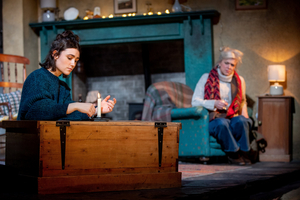Review: THE CROFT, Perth Theatre

![]() Sometimes we just want to get away. We all have our reasons for wanting a bit of peace and quiet in the middle of nowhere but being cut off from the rest of the world isn't necessarily a solution to life's problems.
Sometimes we just want to get away. We all have our reasons for wanting a bit of peace and quiet in the middle of nowhere but being cut off from the rest of the world isn't necessarily a solution to life's problems.
Ali Milles' new thriller, The Croft, follows two stories across multiple timelines that take place in a croft conversion in the west highlands of Scotland.
This debut play from Milles opened at Cheltenham's Everyman Theatre and is now embarking on a UK tour, making a stop in Perth Theatre this week.
When walking into the auditorium the audience is met with the sight of a pseudo-box set of a simple, small rural cottage with touches of turquoise (design by Adrian Linford) in the furniture and fireplace to suggest a modern conversion. Faint sounds of seagulls and crashing waves are heard which transport you to the coast.
Laura (Lucy Doyle) and Suzanne (Caroline Harker) head to the remote village of Coillie Ghillie for a romantic getaway to a holiday home from Laura's childhood. Things are not as they seem and truths about Laura's parents and her upbringing come to light through flashbacks as local villager David (Drew Cain) intrudes on the couple's retreat.
We see timelines overlap between Laura's family and the former residents, Enid (Gwen Taylor) and Eilene (also Doyle) who are resisting the demands of their neighbours to leave as part of the Highland clearances in 1870.
Taylor as Enid is initially unassuming but becomes a haunting figure as the story progresses. Doyle captures the frustration of Laura, as she tries to make the most of her time away with Suzanne, and seamlessly transforms into the troubled Eilene of 1870.
Harker gives an empathetic performance as Suzanne and another character (not to spoil the plot), torn between her lover and other responsibilities.
While the show is centred around the female characters, Cain and Simon Roberts give humanity to the male characters in the show in one timeline, while suitably show patriarchal aggression in the Highland clearances narrative.
Philip Franks direction clearly focuses the overlapping stories, with clear cues between timelines. The costumes help define when it is present-day and when it is 1870.
Pockets of humour are found in the more lighthearted moments of Milles' script and a dramatically choreographed sequence in Act I effectively displays the cobweb of tension between the characters.
Max Pappenheim, responsible for the previously mentioned seascape also composed the music for this play: a lilting, and haunting tune that reprises throughout, played by violinist James Findlay.
Chris Davey's lighting display captures the dullness of the Scottish skyline while also creating spooky effects with sudden blackouts and use of sinister reds in more tense moments.
The piece explores interesting subject matter such as what draws us back to a particular place; what influence our parents have on what we look for in a partner; and the devastating effects of the Highland Clearances.
It features an LGBT storyline with no fuss and while its pacing escalates towards the end in a slightly dissatisfying manner, The Croft is an intriguing and mysterious tale of past and present. The fly on the wall tension and mystery around certain connections people have and the slow revelation of events are highlights of Milles' debut script.
The Croft at Perth Theatre until 8 Feb then continues on tour
Photography credit: Charlotte Graham
Reader Reviews

Videos

